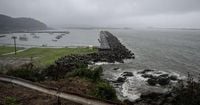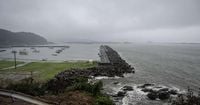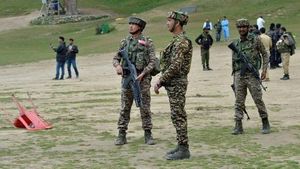Northern Japan was rattled on Sunday evening, November 9, 2025, by a powerful earthquake that sent shockwaves across the region, triggered tsunami advisories, and momentarily disrupted daily life in several coastal communities. According to the Japan Meteorological Agency (JMA), the main quake struck at 5:03 p.m. local time off the coast of Iwate Prefecture, registering a magnitude of 6.9 and a depth between 10 and 20 kilometers (roughly 6 to 12 miles). The tremor was felt as a level 4 on Japan’s Shindo seismic intensity scale, a measurement that indicates strong shaking capable of swinging lights and overturning objects, as reported by NHK and Newsweek.
Immediately after the earthquake, authorities sprang into action. The JMA issued a tsunami advisory for the northeastern coastline, specifically warning residents of Iwate Prefecture to brace for waves potentially reaching up to 1 meter (about 3 feet). In some initial forecasts, meteorologists even warned the water could rise as high as 3 meters (nearly 10 feet) in certain locations, as reported by Newsday and The Japan Times. The advisory was accompanied by urgent messages from officials, including Prime Minister Sanae Takaichi, who posted on X (formerly Twitter), urging people to move away from the coast and stay alert for aftershocks and further tsunami waves. "Remain on alert for aftershocks and tsunami waves that could hit the area," she cautioned, echoing the advice of disaster management authorities.
As the evening unfolded, the situation remained tense. Tsunami waves were detected at several monitoring stations along the coast. The JMA recorded waves of about 10 centimeters (4 inches) at Ofunato city, Ominato port, Miyako, and Kamaishi, with the largest waves—up to 20 centimeters (8 inches)—hitting Kuji and Ofunato ports, according to The Japan Times and Newsweek. Fortunately, these waves were far smaller than the maximum forecast, and by shortly after 8 p.m., the tsunami advisory was officially lifted. However, meteorological officials warned that the region would remain at risk for strong aftershocks for about a week, with the next two or three days being particularly critical, as reported by The New York Times and Kyodo News.
Despite the magnitude of the quake and the initial fears of a significant tsunami, there were no immediate reports of injuries or major damage. Local authorities and the JMA confirmed that the two nuclear power plants in the area—including the Onagawa facility in neighboring Miyagi Prefecture—were operating normally, with no abnormalities detected. This news came as a relief to many, especially given the region’s painful history with nuclear disasters.
Train services, however, did not escape unscathed. According to East Japan Railway (JR East), the Tohoku Shinkansen—the high-speed bullet train line running through the affected region—briefly lost power, resulting in the temporary suspension of operations between Sendai and Shin-Aomori stations. Some local news outlets, including Kyodo News, also reported power outages in unspecified areas, though these were quickly addressed. By the end of the evening, bullet train services were restored and life in the region began to return to a cautious normalcy.
The quake was not an isolated event. By 8:30 p.m., the JMA had recorded at least 11 more tremors in the same area, including one measuring magnitude 6.3 and Shindo 3. Residents of Iwate Prefecture and even the northernmost major island of Hokkaido felt the earth shake repeatedly, keeping nerves on edge and emergency services on high alert. JMA officials, speaking at a news conference, emphasized that earthquakes of similar or even stronger intensity could occur in the coming days.
For many in northeastern Japan, Sunday’s events brought back memories of the catastrophic triple disaster of March 2011, when a massive earthquake, tsunami, and nuclear meltdown devastated the region. Nearly 20,000 people lost their lives—most to the tsunami—and the Fukushima Daiichi nuclear power station suffered severe damage. The scars of that day remain visible: thousands are still displaced from the no-go zone, and periodic demonstrations continue to highlight public concerns about nuclear safety. As recently as Saturday, protests were held to demand greater recognition from authorities of the risks posed by nuclear power, according to The New York Times.
The latest quake, however, was not directly linked to the 2011 disaster. Meteorological officials explained to reporters that there was “nothing to indicate the latest quake was directly related to the one in 2011, except that the region was generally at risk for major quakes, including another one that hit in 1992.” This is little surprise, given Japan’s position atop the Pacific "Ring of Fire"—a 25,000-mile horseshoe-shaped belt notorious for its seismic activity. According to Tokyo’s Foreign Ministry, about 90 percent of the world’s earthquakes occur along this belt, and Japan’s complex coastline makes it especially vulnerable to tsunamis.
In the immediate aftermath, evacuation orders were issued in some coastal municipalities, and disaster portals offered guides on what to do before, during, and after an earthquake. While the advisory was in effect, residents were urged to avoid the ocean and coastal areas, and to prepare for further shaking. As Newsweek explained, even moderate earthquakes can trigger localized tsunamis, and waves may continue for hours, sometimes growing larger with time.
Japan’s resilience in the face of such disasters is well known. Over the decades, the country has developed sophisticated early warning systems, strict building codes, and a culture of preparedness. Yet, as Sunday’s events showed, even with all these measures, the unpredictability of nature can still unsettle daily life. The episode serves as a reminder of the ever-present risks faced by those living in one of the world’s most earthquake-prone nations—and of the importance of vigilance, swift action, and community solidarity.
As the region recovers and keeps a wary eye on seismic reports, the people of northern Japan once again demonstrate their remarkable capacity to endure, adapt, and move forward, even as the ground beneath their feet remains restless.







